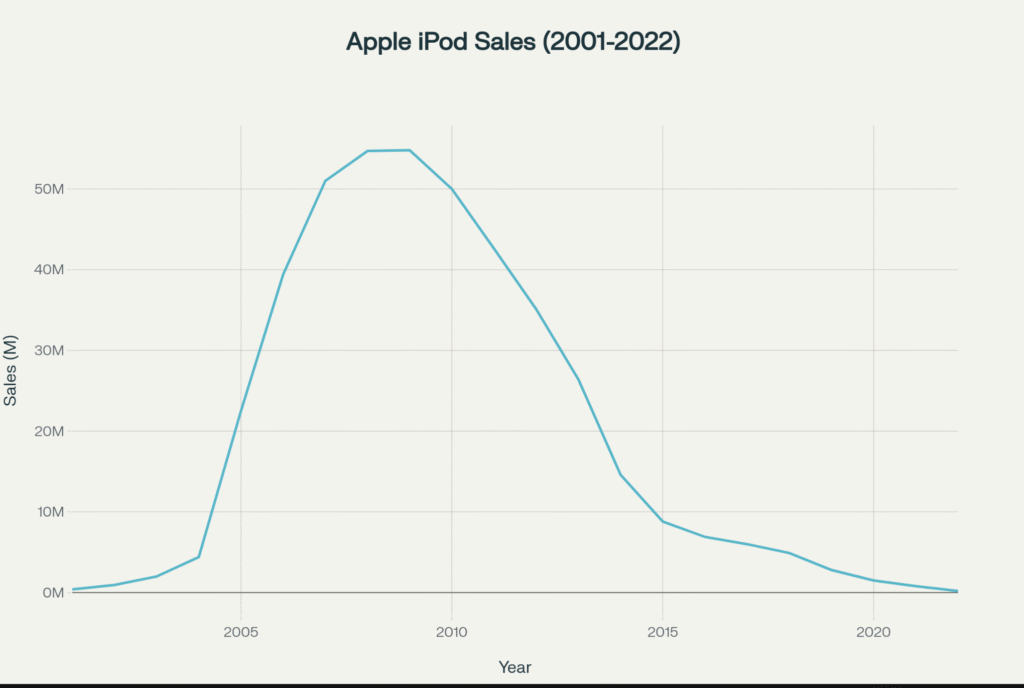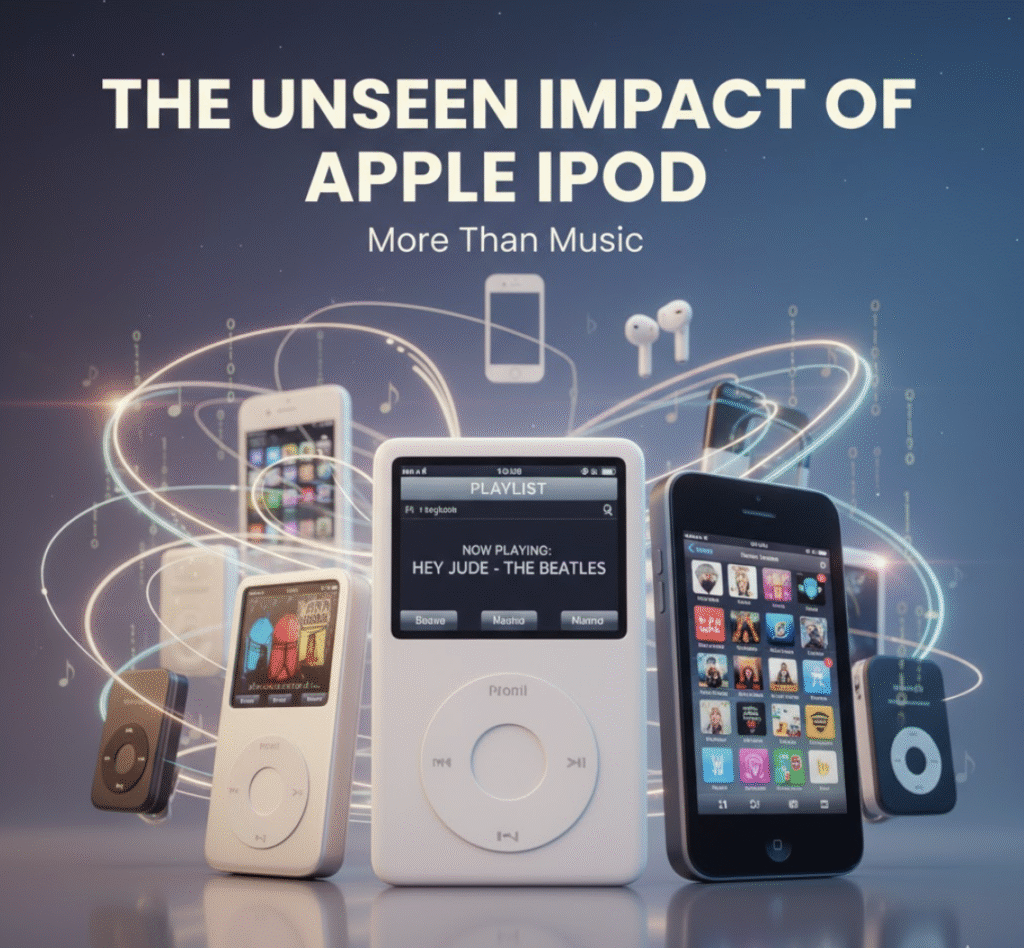Introduction
The Apple iPod is more than just a device; it’s a cultural icon that changed the way the world listens to music. Launched in 2001, the iPod transformed portable music from a simple concept into a global phenomenon. With the ability to store 1,000 songs in a compact device and provide 10 hours of playback, it quickly became a must-have gadget. But the iPod’s influence extended far beyond music: it laid the groundwork for Apple’s future ecosystem, inspiring products like the iPhone, Apple Music, and Apple Watch, and fundamentally reshaping the company’s identity as a hub of innovation, creativity, and personal expression.

Even though the iPod has been discontinued, its impact continues through modern Apple devices and services. Today, Apple Music hosts over 90 million songs and 30,000 curated playlists, continuing the iPod’s legacy of personal music enjoyment. Understanding the iPod’s history, sales trends, software evolution, and cultural impact is crucial to appreciating how one device could change the rhythm of everyday life.
The Rise and Peak of the Apple iPod
The iPod was introduced at a time when digital music was beginning to gain traction but had yet to become mainstream. It revolutionized the concept of carrying music anywhere and offered a level of convenience previously unimaginable. By 2008, Apple had sold nearly 55 million units of iPods in a single year, which accounted for almost 40% of the company’s total revenue. At that time, the iPod dominated the portable media player market with a 70% share overall and over 90% of the hard-drive MP3 player segment in the United States.
Sales data reveals that the iPod Touch, introduced in September 2007, became another blockbuster. By May 2013, it had sold over 100 million units, highlighting Apple’s ability to adapt the iPod into multifunctional devices capable of video playback, apps, and gaming. The seventh-generation iPod Touch, released in May 2019, offered storage options up to 256 GB and 40 hours of audio playback, representing the pinnacle of iPod technology before its eventual discontinuation.
During its golden years, the iPod was an essential revenue driver for Apple. In the first quarter of 2009, it contributed nearly 29% of the company’s total revenue. However, by the fourth quarter of 2014, this share had plummeted to just 1%, amounting to only US$410 million. This decline mirrored broader shifts in consumer preferences toward smartphones and streaming services.
Seasonal Sales and Search Trends
Even after its discontinuation, the iPod continues to attract attention during the holiday season. Data from December 2024 shows the highest search interest for the term “Apple iPod,” with a normalized search volume of 100. Post-holiday searches in January 2025 fell sharply to 58, indicating that demand is heavily seasonal. Amazon sales data aligns with this trend: December 2024 saw 1,549 iPod units sold, the highest in the year, followed by a post-holiday drop to 1,160 units in January 2025.
Sales and searches stabilised somewhat by April 2025, with about 1,100 units sold per month and search activity fluctuating between 2,500 and 3,000 queries. Notably, negative customer reviews—citing screen defects (19.4%) and battery malfunctions (15.8%)—likely contributed to the early-year slump. Despite these challenges, nostalgia and collector interest continue to drive modest sales in the second-hand market.
Software Evolution and Multimedia Capabilities
The iPod was never just a music player. Over its lifetime, Apple significantly advanced its functionality and multimedia capabilities. The 5th and 6th-generation iPod Classics, along with the 3rd-generation iPod Nano, supported video playback in MPEG-4 (H.264) and QuickTime formats. Meanwhile, the iPod Photo expanded its appeal by supporting a variety of image formats, including JPEG, BMP, GIF, TIFF, and PNG, effectively combining music and photo storage in a compact device.
These hardware and software innovations made the iPod a versatile platform for multimedia consumption, cementing its role as a pioneer in portable entertainment. By 2006, iPods accounted for 40% of Apple’s total revenue, but with the rise of the iPhone and streaming services, this percentage dropped dramatically to just 1% by 2014. At its 2007 peak, quarterly iPod sales reached US$7.1 billion, representing 48% of Apple’s revenue for that quarter.
The iPod’s Decline and the Rise of Smartphones
The decline of the iPod was largely inevitable with the rise of the smartphone era. The iPhone, launched in 2007, offered similar capabilities in music playback, apps, and connectivity, effectively “cannibalising” iPod sales. As consumers shifted toward all-in-one devices, standalone music players gradually lost relevance.
Streaming services like Apple Music and Spotify further reduced the need for dedicated music storage, as users could access vast libraries on demand without relying on device memory. By 2015, Apple merged iPod sales into the broader category of “Wearables, Home, and Accessories,” ceasing to report it as a standalone revenue line. Despite this, the iPod’s legacy remained embedded in Apple’s ecosystem, influencing how users interact with music on iPhones, iPads, Apple Watches, and Mac computers.
Resurgence in the Second-Hand Market
Interestingly, the iPod has seen a revival in the second-hand market, fuelled by nostalgia and collector interest. Reports from 2024 indicate that sales of refurbished iPods increased by 15.6% annually, with the U.S., Spain, and Germany leading the demand. Resale platforms like Back Market reported 117% higher holiday sales compared to the rest of the year. Online communities, particularly Reddit forums, also noted rising prices for iPod Classics, ranging from US$50 to US$150 depending on condition and model.
Several factors contribute to this renewed interest. Many consumers value the simplicity and offline playback capabilities of the iPod, as well as the sense of ownership it provides over personal music collections. For retro enthusiasts, the iPod represents a tangible connection to a digital music revolution that shaped the early 21st century.
Legacy of the iPod and Apple’s Music Ecosystem
The iPod’s influence extends far beyond sales numbers. It transformed music consumption and fundamentally shaped Apple’s ecosystem. Greg Joswiak, Apple’s Senior Vice President of Worldwide Marketing, emphasised that the iPod was a major driver of the music revolution, creating new ways for people to listen, share, and interact with music.
Today, Apple Music continues the iPod’s legacy, offering over 90 million tracks and more than 30,000 curated playlists. Modern Apple devices—iPhones, iPads, Apple Watches, Macs, and HomePod minis—provide seamless music experiences that echo the iPod’s original mission: portable, personal, and enjoyable music on the go. The combination of wireless listening, offline playback, and integration across devices fulfills the iPod’s original vision in an updated, modern form.
Apple Revenue Insights and Market Share
During the iPod’s heyday, Apple relied heavily on it for revenue. In 2006, iPods accounted for 40% of total sales, but by 2014, smartphones and streaming platforms had shifted the revenue landscape. By the fourth quarter of 2020, iPhone sales alone contributed over 40% of Apple’s revenue, highlighting the company’s successful pivot from single-function devices to multifunctional ecosystems.
The iPod’s market dominance was impressive. Between January 2004 and January 2005, Apple’s share of the U.S. portable media player market grew from 31% to 65%, reaching 74% by mid-2005. Hard-drive MP3 players saw even higher dominance, with Apple securing over 90% market share at its peak.
iPod Touch: A Modern Classic
The iPod Touch represented Apple’s attempt to modernize the iPod concept. Released in September 2007, it included app capabilities, gaming features, and internet connectivity. By May 2013, it had sold over 100 million units, making it one of Apple’s most successful product lines. The final release in May 2019 offered storage options from 32 GB to 256 GB, an A10 Fusion chip, and up to 40 hours of music playback. It symbolized the evolution of the iPod from a music player to a multifunctional device capable of supporting Apple’s expanding ecosystem.
Despite its discontinuation in May 2022, the iPod Touch remains a beloved device among collectors and retro enthusiasts, representing the enduring appeal of simplicity and music-focused design.
Cultural Impact and Nostalgia
The iPod’s influence transcends technology and sales; it shaped culture and consumer behavior. For many, it represents a nostalgic era of music discovery and personal playlists. Its design, portability, and user-friendly interface set a standard for personal electronics, inspiring future Apple products and influencing the broader tech industry.
Collectors and enthusiasts continue to celebrate the iPod through online communities, retro-themed discussions, and resale markets. Its offline music capabilities, simplicity, and focus on personal ownership resonate with users who prefer a dedicated music device over modern streaming subscription models.
Conclusion
The Apple iPod remains one of the most significant technological innovations of the 21st century. From revolutionizing music consumption to shaping Apple’s product ecosystem, it left an indelible mark on the tech industry and popular culture. While the device itself is no longer in production, its influence persists through Apple Music, iPhones, iPads, and other devices that continue the mission of portable, personal, and enjoyable music experiences.
Today, the iPod is more than nostalgia; it is a symbol of innovation, creativity, and the personal connection people have with music. Its legacy reminds us how one device can redefine an industry, create cultural waves, and inspire decades of technological advancement. Even in 2025, the iPod’s story continues to resonate, proving that great design and visionary thinking never go out of style.


